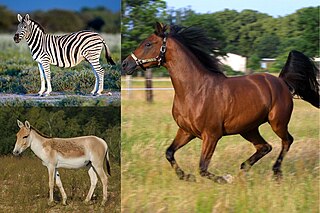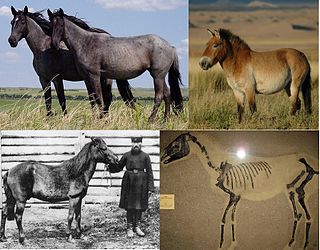
Equidae is the taxonomic family of horses and related animals, including the extant horses, asses, and zebras, and many other species known only from fossils. The family evolved around 50 million years ago from a small, multi-toed ungulate into larger, single-toed animals. All extant species are in the genus Equus, which originated in North America. Equidae belongs to the order Perissodactyla, which includes the extant tapirs and rhinoceros, and several extinct families.

The plains zebra, also known as the common zebra, is the most common and geographically widespread species of zebra. Its range is fragmented, but spans much of southern and eastern Africa south of the Sahara. Six or seven subspecies have been recognised, including the extinct quagga which was thought to be a separate species. More recent research supports variations in zebra populations being clines rather than subspecies.

The mountain zebra is a zebra species in the family Equidae, native to southwestern Africa. There are two subspecies, the Cape mountain zebra found in South Africa and Hartmann's mountain zebra found in south-western Angola and Namibia.

Equus is a genus of mammals in the family Equidae, which includes horses, asses, and zebras. Within the Equidae, Equus is the only recognized extant genus, comprising seven living species. Like Equidae more broadly, Equus has numerous extinct species known only from fossils. The genus most likely originated in North America and spread quickly to the Old World. Equines are odd-toed ungulates with slender legs, long heads, relatively long necks, manes, and long tails. All species are herbivorous, and mostly grazers, with simpler digestive systems than ruminants but able to subsist on lower-quality vegetation.

The wild horse is a species of the genus Equus, which includes as subspecies the modern domesticated horse as well as the endangered Przewalski's horse. The European wild horse, also known as the tarpan, that went extinct in the late 19th or early 20th century has previously been treated as the nominate subspecies of wild horse, Equus ferus ferus, but more recent studies have cast doubt on whether tarpans were truly wild or if they actually were feral horses or hybrids.

The Cape mountain zebra is a subspecies of mountain zebra that occurs in certain mountainous regions of the Western and Eastern Cape provinces of South Africa.

Hippidion is an extinct genus of equine that lived in South America from the Late Pliocene to the end of the Late Pleistocene (Lujanian), between 2.5 million and 11,000 years ago. They were one of two lineages of equines native to South America during the Pleistocene epoch, alongside Equus (Amerhippus) neogeus.
Metatomarctus is an extinct genus of the Borophaginae subfamily of canids native to North America. It lived during the Early to Middle Miocene, 23–16 Mya, existing for approximately 7 million years It was an intermediate-size canid, and more predaceous than earlier borophagines.

The latter half of the Late Pleistocene to the beginning of the Holocene saw extinctions of numerous predominantly megafaunal species, which resulted in a collapse in faunal density and diversity across the globe. The extinctions during the Late Pleistocene are differentiated from previous extinctions by the widespread absence of ecological succession to replace these extinct megafaunal species, and the regime shift of previously established faunal relationships and habitats as a consequence. The timing and severity of the extinctions varied by region and are thought to have been driven by varying combinations of human and climatic factors. Human impact on megafauna populations is thought to have been driven by hunting ("overkill") as well as possibly environmental alteration. The relative importance of human vs climatic factors in the extinctions has been the subject of long-running controversy.

Haringtonhippus is an extinct genus of equine from the Pleistocene of North America The genus is monospecific, consisting of the species H. francisci, initially described in 1915 by Oliver Perry Hay as Equus francisci. Prior to the naming of the genus, it was sometimes referred to as the New World stilt-legged horse, in reference to its slender distal limb bones, in contrast with those of contemporary "stout legged" caballine true horses.

Theriodictis is an extinct genus of hypercarnivorous wolf-like canid endemic to South America during the Pleistocene, living from 1.2 Ma- 500,000 years ago and existing for approximately 0.7 million years.

Equus conversidens, or the Mexican horse, is a dubious Pleistocene species of horse, now extinct, that inhabited North America.
Equus alaskae was a Pleistocene species of horse, now extinct, that inhabited North America.
Equus semplicatus was a Pleistocene species of New World stilt-legged horse, and considered the type species for the stilt legged horses, one of three lineages of equids within the Americas, the other two being hippidionid and caballine horses. Now extinct, Equus semiplicatus once inhabited North America.

Illaenus is a genus of trilobites from Russia and Morocco, from the middle Ordovician.
The montane Sumatran white-bellied rat, also known as the Montane Sumatran niviventer, is a species of rodent in the family Muridae. It is found in the montane forests along the mountains of western Sumatra, Indonesia.
The Coso Formation is a geologic formation in the Coso Range of the Mojave Desert, in Inyo County, California.
The San Antonio Formation is a middle to late Pleistocene geologic formation in California. It preserves fossils.
Equus niobrarensis is an extinct species of Equus, the genus that includes the horse. E. niobrarensis may be synonymous with Equus scotti. It was "stout-legged" and belonged to the "big horses" category as defined by M. C. Winans. The skull of the horse was noted as being broader than Equus caballus.











